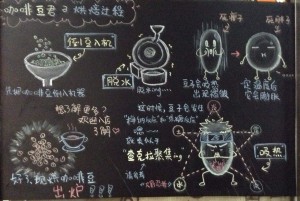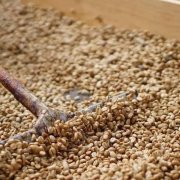From coffee cherries to coffee raw beans to coffee cooked beans, our boutique coffee
Every year in October, coffee from all over the world slowly enters the ripening period, and every step of this red fruit will affect its taste from the moment it is picked.

Coffee bean production process
Step.1 picking. Generally speaking, fruits that turn red can be picked, but in some places, there is no strict quality control, and some unripe fruits will also be picked. This is the most common defective bean, white bean, when we deal with coffee beans.
Step.2 to remove the pulp, this is what we often call coffee treatment: washing, drying.
Washing type, that is, after the fresh fruit is fermented in water, part of the pericarp is removed; the drying type, such as sun beans, that is, after the fresh fruit is fully dried, the peel will separate and fall off by itself, and then use a sheller to remove the shell.
Generally speaking, washed beans will be very refreshing, without too much miscellaneous flavor, while dried beans will have more flavor changes.
Step3. After treatment, we got a lot of green coffee beans. After grading and screening, different grades of beans are obtained, and the coffee roaster will determine the different baking depth according to the characteristics of these beans.
Step4, this step, naturally is baking, there are many ways to bake, you can directly stir-fry beans, or use hand network baking, professional barista, of course, is to use a professional coffee roaster.

Coffee bean baking process
Step5. Take the professional coffee roaster as an example, the first thing is to preheat the machine first. When the temperature in the machine reaches a certain temperature, the beans begin to drop. After the coffee beans are dehydrated, the temperature in the chamber continues to rise. With the increase of temperature, besides the change of color, the volume will also change accordingly. With the Mena reaction and caramelization reaction, the coffee will go through the first explosion, the first explosion density, the end of the first explosion, the second explosion, the second explosion, and the end of the second explosion. The coffee roaster decides to come out of the oven differently according to the beans. After the beans are cooled, they are ground into powder, which is the raw material from which we begin to brew coffee-coffee powder.
Important Notice :
前街咖啡 FrontStreet Coffee has moved to new addredd:
FrontStreet Coffee Address: 315,Donghua East Road,GuangZhou
Tel:020 38364473
- Prev

Measurement data record of Sanani Mocha Cup during the Transformation process of Mocha Coffee in Yemen
Yemeni mocha coffee has a unique flavor, some people say that in the coffee, Blue Mountain can be king, mocha can be called queen. Mocha is like love, sweet in bitterness and bitter in bitterness, just like the ups and downs of love. It's about something called happiness. Yemeni mocha is one of the oldest coffee in the world, but until recently, Yemeni mocha has come to be regarded as the best and most beautiful in the world.
- Next

One of the two kinds of coffee in the world, Mantenin is a mellow and elegant boy.
One of the most famous and most needed coffee in Asia. The appearance of Mandarin beans is arguably the ugliest, but coffee fans say that the more ugly the Sumatran coffee beans are, the better, mellow and slippery they are. In the 17th century, the Dutch first introduced Arabica saplings to Ceylon (present-day Sri Lanka) and Indonesia. In 1877, a massive disaster struck Indonesia.
Related
- Beginners will see the "Coffee pull flower" guide!
- What is the difference between ice blog purified milk and ordinary milk coffee?
- Why is the Philippines the largest producer of crops in Liberia?
- For coffee extraction, should the fine powder be retained?
- How does extracted espresso fill pressed powder? How much strength does it take to press the powder?
- How to make jasmine cold extract coffee? Is the jasmine + latte good?
- Will this little toy really make the coffee taste better? How does Lily Drip affect coffee extraction?
- Will the action of slapping the filter cup also affect coffee extraction?
- What's the difference between powder-to-water ratio and powder-to-liquid ratio?
- What is the Ethiopian local species? What does it have to do with Heirloom native species?

